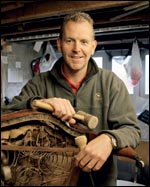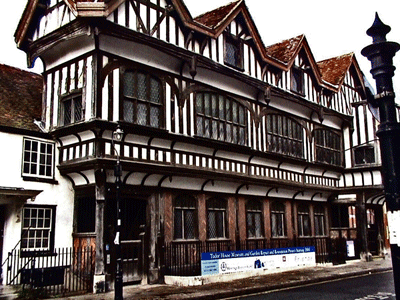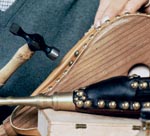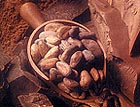Traditional upholsterer guide
Tips and advice on how to approach the reupholstering of a well loved piece of furniture


A well-upholstered piece of furniture can last for generations. Early examples which still have their original upholstery include a 16th century X-frame chair and an early-17th-century settee from Knole in Kent, although pieces in everyday use may need to be reworked every 20 to 50 years. 'The oldest pieces I've worked with were some Chippendale-style chairs from about 1760,' says traditional upholsterer Stuart Beaumont. 'The owners were keen to keep using them, so I simply reupholstered them in exactly the same way as they had been done originally.'
Mr Beaumont runs St Austell Upholstery in Cornwall, which he bought from his parents in 2001. He is the Assistant Secretary of the Guild of Traditional Upholsterers and also teaches the craft. His small team at St Austell deals with an eclectic range of projects that reflect the various uses of upholstery. 'At the moment, I'm working on a Victorian balloon-back chair, a little Victorian nursing chair with a deep button back, two relatively modern sofas, a modern armchair and some dining-room chairs. One of my favourite projects was a wheelchair dating from about 1820 which was owned by a theatre company.'
The materials of the trade have evolved with fashion and technical developments horsehair replaced feathers or straw as a stuffing in the late 17th century, for example, and springs became common after the Industrial Revolution but the basic techniques remain little altered. One of the most common items to be reworked is an 18th-century dining room chair. Mr Beaumont begins by completely removing the old upholstery, taking care to work in the direction of the wood grain. He then strings a 2in-wide webbing, made from flax and cotton, across the seat frame, first from back to front and then interwoven from side to side. The webbing must be taut, but not so much that it distorts the frame. Next, a 15oz hessian is added (the quality is determined by weight the jute yarn is thicker and more tightly woven in a 15oz hessian than in a 10oz one). This is stretched tightly to provide the support for the stuffing.
The stuffing is generally horsehair, but cow tail and hog hair can also be used. The hair must first be 'roped' twisted and weighted down for a period of time to give it the curliness that provides resilience and bulk. The average dining chair will require 3lbs to 4lbs of hair, added to the seat in two stuffings. The first stuffing, which uses the majority of the hair, is secured with linen 'bridle ties', which are stitched into the hessian around the seat and across the hair. This layer is covered with scrim (a very fine version of hessian), which is tacked around the edge and held in place using 'stuffing ties', stitched vertically as well as horizontally, to hold the stuffing in a three-dimensional lattice.
Once all these layers have been stitched around the frame, more bridle ties secure the shallower second stuffing, which is covered with a layer of cotton wadding secured by a layer of calico. Finally, this is covered by skin wadding (traditionally known as swan down), followed by the top cover. 'If I'm not interrupted, I'll get a chair done in a day. It works out at about £300 to reupholster a typical chair.'
Stuart Beaumont, St Austell Upholstery, Cornwall 01726 74626; www.staustellupholstery.co.uk
Top tips
Sign up for the Country Life Newsletter
Exquisite houses, the beauty of Nature, and how to get the most from your life, straight to your inbox.
Fibres such as coconut can be used as a cheaper alternative to horsehair, but are far less durable
Using staples, rather than tacks, to fix fabric causes less damage to the wood It is not always necessary to completely reupholster a piece; top covers wear out, but much of the rest can often be kept
Country Life is unlike any other magazine: the only glossy weekly on the newsstand and the only magazine that has been guest-edited by HRH The King not once, but twice. It is a celebration of modern rural life and all its diverse joys and pleasures — that was first published in Queen Victoria's Diamond Jubilee year. Our eclectic mixture of witty and informative content — from the most up-to-date property news and commentary and a coveted glimpse inside some of the UK's best houses and gardens, to gardening, the arts and interior design, written by experts in their field — still cannot be found in print or online, anywhere else.
-
 ‘It had the air of an ex-rental, and that’s putting it politely’: How an antique dealer transformed a run-down Georgian house in Chatham Dockyards
‘It had the air of an ex-rental, and that’s putting it politely’: How an antique dealer transformed a run-down Georgian house in Chatham DockyardsAn antique dealer with an eye for colour has rescued an 18th-century house from years of neglect with the help of the team at Mylands.
By Arabella Youens Published
-
 You're having a giraffe: Country Life Quiz of the Day, April 25, 2025
You're having a giraffe: Country Life Quiz of the Day, April 25, 2025Friday's Quiz of the Day brings your opera, marathons and a Spanish landmark.
By Toby Keel Published
-
 How to prepare your house for winter
How to prepare your house for winterAs winter approaches, experts advise that preventative measures are crucial for our houses to weather hard winters
By Country Life Published
-
 Ten house tips for the winter
Ten house tips for the winterNow is the time to put your house in ship-shape for the winter months ahead. Chartered surveyor Tom Grillo shares his ten top tips
By Country Life Published
-
 Choosing an interior designer
Choosing an interior designerFinding the right skilled interior designer for your period property requires some dedication; in particular you need to make sure you share the same vision
By Country Life Published
-
Maintenance tips for Victorian houses
There are a number of aspects to look out for when viewing or indeed owning a Victorian house
By Country Life Published
-
 Best cooking pans
Best cooking pansMrs Danvers suggests the best makes of pots and cooking pans to hunt down when shopping for a special friend's wedding present
By Country Life Published
-
How to save old floorboards
Lots of care and elbow grease can help old floorboards gleam again
By Country Life Published
-
 Buying bellows
Buying bellowsMrs Danvers recommends where to find a new or antique pair of bellows
By Country Life Published
-
 Removing chocolate stains
Removing chocolate stainsMrs Danvers tackles readers' household queries: this week's are chocolate stains on a linen suit and screen doors
By Country Life Published
